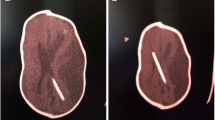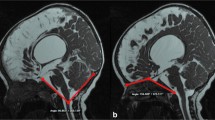Abstract
A small number of human fetal hydrocephalics have been treated by ventriculoamniotic shunts of silastic tubing [2, 5, 7, 8, 10, 22]. The Colorado device appears to be the one most commonly used [2]. The original experimental device tested on a primate model resembled a hollow shingle nail. This was designed by Michedja and Hodgen, contained a spring valve, measured approximately 32×4 mm and was placed by hysterotomy [16]. An attractive feature of this design was its fixation by impaction in the skull, preventing displacement by fetal activity, a reported disadvantage with the silastic devices [2, 10]. To our knowledge, no one has used this nail-like design and tailored it to transuterine percutaneous placement in a human case.
Similar content being viewed by others
References
Bottoms SF, Rosen MG, Sokol RJ (1980) The increase in cesarian birth rate. N Engl J Med 302:559–563
Clewell WH, Johnson MJ, Meier PR, Newkirk JB, Zide SL, Hendee RW, Bowes WA Jr, Hecht F, O'Keefe D, Henry GP, Shikes RH (1982) A surgical approach to the treatment of fetal hydrocephalus. N Engl J Med 306:1320–1325
Cochrane DD, Myles ST (1982) Management of intrauterine hydrocephalus. J Neurosurg 57:590–596
Denhaus H, Winsberg F (1979) Ultrasonic measurement of the fetal ventricular system. Radiology 131:781
Duncan CC, Berkowitz RL, Hobbins JC (1982) Fetal hydrocephalus: an approach to management. Presented at the 32nd annual meeting of the Congress of Neurological Surgeons, Toronto, Canada, October 1982
Foltz EL, Shurtleff DD (1963) Five year comparative study of hydrocephalus in children with and without operation (113 cases). J Neurosurg 20:1064–1079
Frigoletto FD Jr, Birnhelz JC, Greene MF (1982) Antenatal treatment of hydrocephalus by ventriculo-amniotic shunting. JAMA 248:2496–2497
Gilmore A (1983) Is the fetus a patient? Can Med Assoc J 128:1472–1476
Grix A Jr, Curry C, Hall BD (1982) Patterns of multiple malformations in infants of diabetic mothers. Birth Defects 18:55–77
Harrison RM, Filly RA, Golbus MS (1982) Fetal treatment. Conference report. N Engl J Med 307:1651–1652
Hobbins JC, Granum PAT, Berkowitz RL, Silverman R, Mahoney MJ (1979) Ultrasound in the diagnosis of congenital anomalies. Am J Obstet Gynecol 134:331–345
Kirkinen P, Suramo I, Jouppila P, Herva R (1982) Combined use of ultrasound and computed tomography in the evaluation of fetal intracranial abnormality. J Perinat Med 10:257–265
Lavery JP, Kubarych SF, Queenan JT (1980) Neural tube defect discovered at routine ultrasound evaluation. JCU 8:55–57
Liechty EA, Bull MS, Bryson CQ, Kalsbeck JE, Jansen RD, Lemans JA, Schreiner RL (1983) Developmental outcome of very low birth weight infants requiring ventriculoperitoneal shunts. Child's Brain 10:340–349
Mealey J Jr, Gilmor RL, Bubb MP (1973) The prognosis of hydrocephalus overt at birth. J Neurosurg 39:348–355
Michejde M, Hodgen GD (1981) In utero diagnosis and treatment of non-human primate fetal skeletal anomalies. I. Hydrocephalus. JAMA 246:1093–1097
Pearson JF (1983) Fetal surgery. Arch Dis Child 58:324–325
Raimondi AJ, Soare P (1974) Intellectual development in shunted hydrocephalic children. Am J Dis Child 127:664–671
Robin RC, Hockwald GM, Tiell M, Mizutani H, Ghatak N (1976) Hydrocephalus. I. Histological and ultrastructural charges in the preshunted cortical mantle. Surg Neurol 5:109–114
Tew B, Laurence KM (1975) The effects of hydrocephalus on intellectual intelligence, visual perception and school attainment. Dev Med Child Neurol [Suppl] 17:129–134
Weller RO, Shulman K (1972) Infantile hydrocephalus: clinical histological and ultrastructural study of brain damage. J Neurosurg 36:255–265
Wilberger JE Jr, Baghai P (1983) Fetal Neurosurg 13:596–600
Author information
Authors and Affiliations
Rights and permissions
About this article
Cite this article
Saunders, R.L., Simmons, G.M., Edwards, W.H. et al. A cranial nail for fetal shunting. Child's Nerv Syst 1, 185–188 (1985). https://doi.org/10.1007/BF00735737
Issue Date:
DOI: https://doi.org/10.1007/BF00735737




